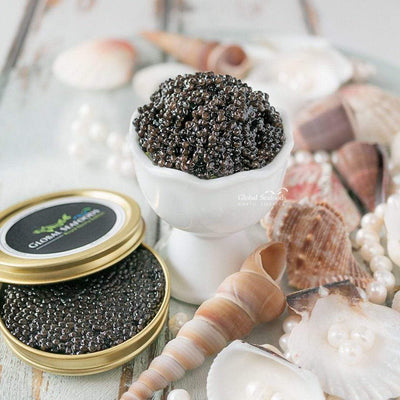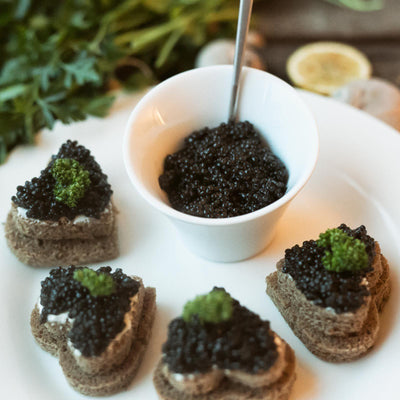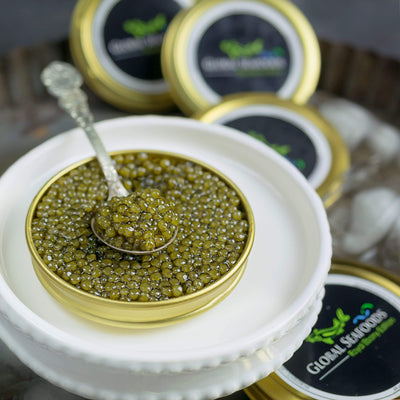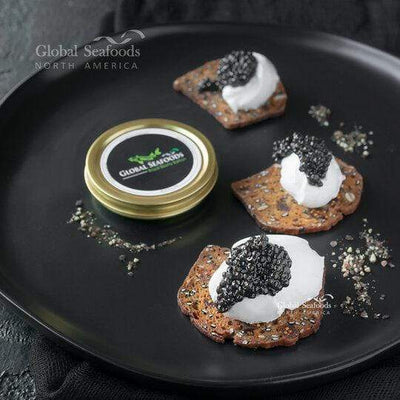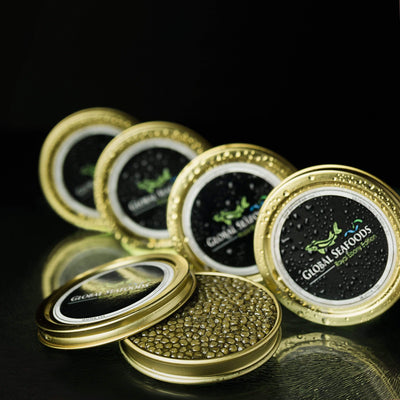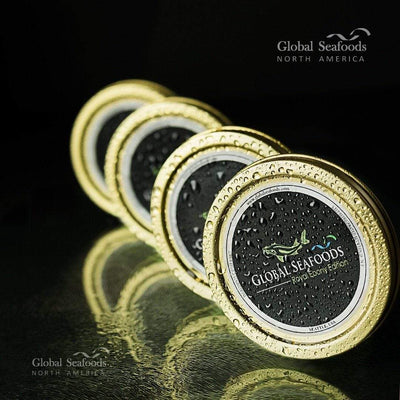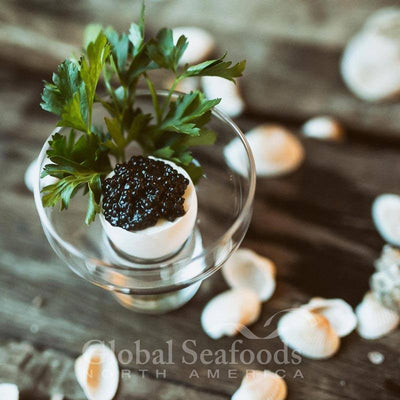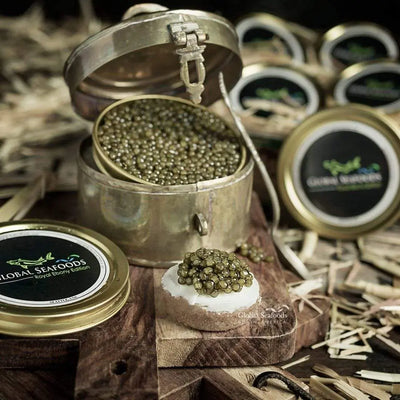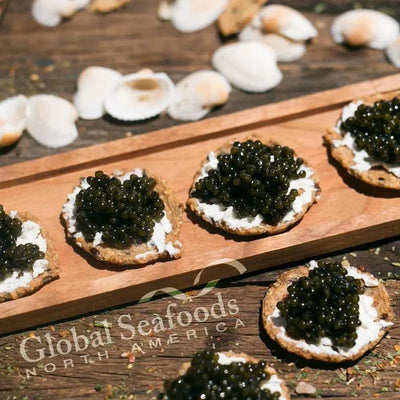How to Make Osetra Caviar at Home: A Step-by-Step Guide

Make Osetra Caviar at Home
Osetra caviar is one of the most luxurious and sought-after culinary delicacies in the world. Traditionally harvested from the Acipenser gueldenstaedtii sturgeon, Osetra caviar boasts a nutty, buttery flavor and a delicate texture that makes it a favorite among gourmands. But did you know it’s possible to make this delicacy at home? While it requires precision and care, the process can be a rewarding culinary experience. This guide will walk you through the steps of making Osetra caviar at home, from sourcing roe to curing it to perfection.
Visit the Global Seafoods YouTube Channel for More Caviar Tips
Why Make Caviar at Home?
Making your own caviar allows you to control every aspect of the process, from sourcing roe to adjusting the salinity level. For culinary enthusiasts, crafting homemade Osetra caviar can be an opportunity to connect with food traditions and create something truly unique.
Quote: “Food is not just sustenance; it’s an expression of artistry and tradition.” – Alice Waters, Chef and Advocate for Sustainable Food
Understanding Osetra Caviar
Osetra caviar is prized for its medium-sized, firm eggs, which range in color from dark brown to golden amber. Its nutty, briny flavor pairs beautifully with a variety of dishes, making it a versatile ingredient for gourmet cooking.
When making Osetra caviar, the two most critical components are the quality of the roe and the salting process. Both significantly impact the flavor, texture, and shelf life of the finished product.
What You’ll Need to Make Osetra Caviar
To make Osetra caviar at home, you’ll need:
- Fresh Sturgeon Roe: Look for high-quality roe from sustainable sources. If you can’t source sturgeon roe, try alternatives like Paddlefish Caviar.
- Non-Metallic Bowls and Spoons: Avoid metal utensils as they can alter the flavor of the caviar.
- Salt: Use high-quality, non-iodized salt for curing the roe.
- Fine Mesh Sieve: Essential for cleaning and separating the eggs.
- Clean Water: Use filtered water to ensure purity.
- Thermometer: To monitor the temperature during preparation.
Step-by-Step Guide to Making Osetra Caviar
1. Sourcing the Roe
- Obtain fresh, high-quality sturgeon roe from a trusted supplier or local fish market. Sustainable options, such as California White Sturgeon Caviar, are excellent choices for homemade caviar.
- Inspect the roe to ensure it is fresh, clean, and free from impurities.
2. Separating the Eggs
- Carefully separate the roe from the membrane (skein) using a non-metallic sieve.
- Gently massage the eggs to release them while avoiding damage.
3. Rinsing the Roe
- Place the eggs in a bowl of cool, filtered water. Stir gently to remove any remaining impurities or membrane pieces.
- Repeat this process until the water is clear.
4. Salting the Roe
- Prepare a saline solution using non-iodized salt. For a classic Osetra flavor, aim for a salinity level of 3-5%.
- Submerge the cleaned eggs in the salt solution for 10–15 minutes, depending on your desired saltiness.
- Taste-test the eggs during this step to ensure the perfect flavor.
5. Draining and Drying
- Once the eggs are salted, transfer them to a fine sieve and let them drain.
- Spread the eggs on a clean surface to air dry for a few minutes.
6. Storing the Caviar
- Store your caviar in a glass container or a caviar tin. Ensure it’s sealed tightly and refrigerated at a temperature between 28°F and 32°F.
- Consume within 2–3 days for the best flavor and texture.
Tips for Perfect Homemade Caviar
- Quality Is Key: High-quality roe is non-negotiable for making great caviar.
- Avoid Overhandling: Be gentle with the eggs to preserve their delicate texture.
- Experiment with Salinity: Adjust the salting time to suit your personal taste.
- Serve Properly: Use a non-metallic spoon, and serve chilled on blinis with crème fraîche.
Pairing and Enjoying Homemade Caviar
Homemade Osetra caviar is best enjoyed simply, allowing its natural flavors to shine. Pair it with:
- Classic Accompaniments: Blinis, crème fraîche, and chives.
- Drinks: Dry Champagne or premium vodka.
Sustainable Sourcing: A Note on Ethics
Sustainability is essential when sourcing roe for homemade caviar. Overfishing has endangered many sturgeon species, so look for sustainable and ethical suppliers like Global Seafoods, which offers a variety of responsibly sourced caviar options, including Kaluga Caviar and Siberian Sturgeon Caviar.
FAQs About Making Osetra Caviar
Q1: Can I use other fish roe to make caviar at home?
A1: Yes, alternatives like salmon or Paddlefish Caviar can be used, though the flavor will differ from sturgeon caviar.
Q2: How long does homemade caviar last?
A2: Homemade caviar should be consumed within 2–3 days for optimal freshness.
Q3: Is making caviar at home expensive?
A3: While sourcing high-quality roe can be costly, making your own caviar is often more affordable than purchasing pre-made options.
Q4: What’s the difference between Osetra and Beluga caviar?
A4: Osetra has a nutty, buttery flavor, while Beluga is milder and creamier. Explore Beluga Caviar for a luxurious comparison.
Q5: How do I know if my roe is fresh?
A5: Fresh roe should have a clean, oceanic scent and firm, glossy eggs.
Conclusion: Crafting Osetra Caviar at Home
Making Osetra caviar at home is a rewarding process that allows you to enjoy this gourmet delicacy with a personal touch. By carefully sourcing your roe, following precise salting techniques, and serving it with care, you can create a caviar experience that rivals even the finest store-bought options.
For the best ingredients and inspiration, browse Global Seafoods’ Caviar Collection and elevate your culinary journey today.
Also in News

How to Make Sea Bream Sushi With Dry-Aged Tuna & Crab Roll — Step-by-Step With Chef Joshua
A complete guide to making Sea Bream sushi at home, including filleting, curing, slicing, and building a Dry-Aged Tuna & Crab sushi roll. Chef Joshua shares professional tips for restaurant-quality results.

Boiled Crab for Game Night: Everything You Need for a Perfect Seafood Party
Take your game night to the next level with a Boiled crab party. Learn the best recipes, cooking tips, and hosting hacks for a memorable seafood feast.

Boiled Crab for Date Night: A Romantic Guide to the Perfect Seafood Feast
Make your next date night unforgettable with a romantic Boiled crab experience. This guide covers everything you need to know, from ambiance to the best crab varieties.

